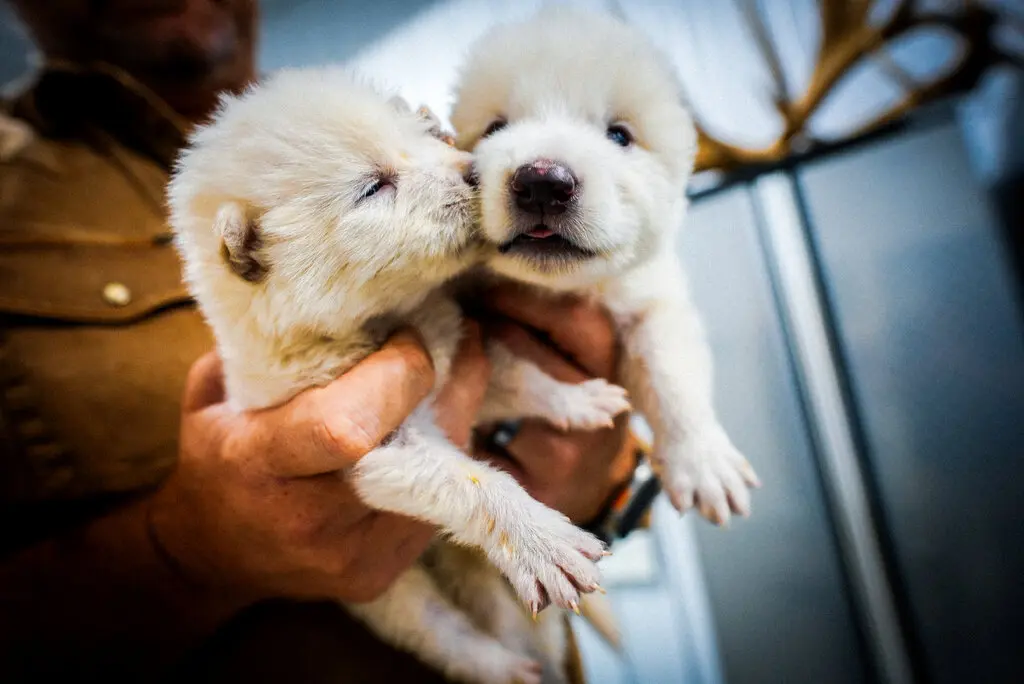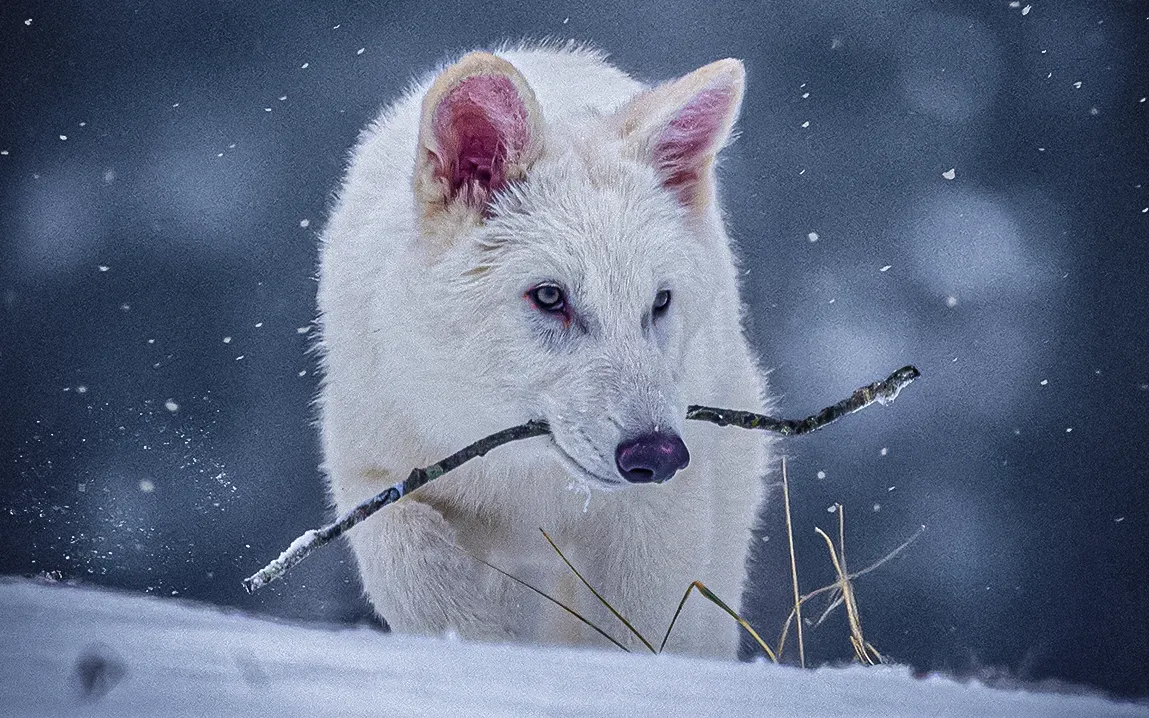The dire wolf, the legendary predator made famous by the series Game of Thrones, went extinct over 13,000 years ago. But now, researchers from Colossal Biosciences say they’ve created gray wolf pups carrying key genetic traits of the extinct species, which potentially makes this the first successful step in de-extinction.
The three pups — two males named Romulus and Remus, and a female named Khaleesi — were born from gray wolf embryos genetically edited to include 20 specific genes from dire wolves. They’re larger than typical gray wolves, with thick, pale coats, bushy tails, and mane-like neck fur. All of their traits are believed to resemble their prehistoric ancestors.
“We’re creating these functional copies of something that used to be alive,” said Dr. Beth Shapiro, chief scientific officer at Colossal and part of the team that first retrieved dire wolf DNA in 2021. “It’s the simplest path to get a predictable result.”
The pups are being raised on a private 2,000-acre facility in the northern U.S. and will remain in captivity, at least for now.
What Is De-Extinction?
De-extinction is the idea of using genetic science to bring back traits or proxies of extinct species. While these engineered animals are not genetically identical clones, they are biological recreations built using DNA data from extinct species and modified through gene editing.
Colossal, founded in 2021 and currently valued at $10 billion, has launched high-profile efforts to bring back not only dire wolves, but also woolly mammoths and the dodo. The company’s approach avoids the need for intact frozen cells (which would allow true cloning), instead focusing on editing the DNA of living relatives to recreate the extinct animals’ defining features.
The Dire Wolf Comeback Plan
Dire wolves, which once roamed across the U.S. and southern Canada in ancient times, were 25% larger than modern gray wolves and hunted large prey like bison, horses, and possibly mammoths. They disappeared during the last Ice Age, likely due to a combination of climate change and the extinction of their prey.
Using fossil samples, including a 13,000-year-old tooth from Ohio and a 72,000-year-old skull from Idaho, researchers recovered enough dire wolf DNA to identify 80 distinct genes that set them apart from gray wolves. Among these were genes related to body size, fur density, and coloration.
“Dire wolves were more than 99% genetically identical to gray wolves,” said Dr. Julie Meachen, a paleontologist at Des Moines University. “But some genes made a huge difference — especially in size and appearance.”
How the Wolf Pups Were Created?
The team started by isolating gray wolf blood cells and editing their DNA to include 15 dire wolf genes directly. The remaining 5 genes, while originally dire-wolf-specific, were modified to safer versions after scientists discovered they could cause blindness or deafness in modern wolves.
“It’s a fine line you have to walk,” Shapiro explained. “You want to resurrect these phenotypes, but not harm the animal.”
These edited cells were inserted into empty dog eggs, forming embryos that were then implanted into large domestic dogs as surrogate mothers.

Out of dozens of implanted embryos, four pups were born. One died after 10 days from a ruptured intestine, but an autopsy confirmed the death was not linked to genetic editing. The three surviving pups are reportedly thriving and healthy.
“That first flash of white fur was a real slap in the face,” said Matt James, Colossal’s chief animal officer. “It’s going to stick in my memory forever.”
What Makes These Wolves ‘Dire’?
The pups are already showing physical traits not seen in gray wolves:
- Roughly 20% larger than average gray wolf pups
- Thick white coats, bushy tails, and mane-like fur
- Bone structure and muscle mass suggest they may grow even larger
However, behavioral differences are harder to confirm. Raised in a controlled environment, the wolves may not exhibit true dire wolf behavior.
“I would love to know the natural behavior of a dire wolf,” Shapiro said. “But these animals are living the Ritz Carlton lifestyle. They can’t get a splinter without us knowing about it.”
Not Quite Clones, But Still Important
While Colossal calls the project a de-extinction success, some experts caution against calling the pups true dire wolves.
“It’s exciting that we can make functional versions of extinct species,” said Adam Boyko, a geneticist at Cornell. “But these aren’t real dire wolves.”
Boyko notes that while 20 dire wolf genes were added, it’s unclear how many genes actually define the species. “It could be 20, or it could be 2,000,” he said. The pups aren’t learning behaviors from dire wolf packs or eating Ice Age prey, which also means their gut microbiomes and instincts will differ.
Implications for Conservation
The gene-editing techniques developed through this project could have real-world impact for living species, too. One candidate was the critically endangered red wolf, now found only in North Carolina.
In 2022, hybrid red wolf-coyotes were discovered in Texas and Louisiana. On the same day they announced the dire wolf pups, Colossal also revealed it had successfully cloned four of these hybrids, which could potentially improve the genetic diversity of the struggling red wolf population.
“The technology that brought these wolf pups to life may also help prevent extinctions of species still hanging on,” Shapiro said.
Bigger Ethical and Ecological Questions Remain
While some are celebrating this achievement, others urge caution.
“We have trouble managing the wolves we have today,” said Meachen. “All the little-kid feelings in me say that I want to see what they look like. But I have questions.”
There are also political pressures. In the U.S., gray wolves remain a controversial species, with some lawmakers pushing to remove them from the endangered species list. Environmental groups warn this could lead to increased hunting and rapid population decline.
“If signed into law, the bill would effectively sign death warrants for thousands of wolves across the country,” warned 60 environmental groups in a joint statement.
Even if dire-wolf-like animals were reintroduced into the wild, they would face a dramatically different ecosystem. Their natural prey, bison, horses, and mammoths are gone or endangered. Any released animals would need to compete with existing wolves for smaller prey, creating new ecological and conservation challenges.
The Future of De-Extinction
For now, Romulus, Remus, and Khaleesi remain in private care, under close scientific observation. But their birth shows the big step in the field of synthetic biology and opens up new discussions about how far science should go in recreating the past.
“Its presence would remind us of our responsibility as stewards of the Earth,” said Mark Fox, tribal chairman of the MHA Nation in North Dakota, one of several Native American groups consulted by Colossal.
Whether it’s the dire wolf, the mammoth, or the dodo, Colossal’s ambitions are bold. But as the wolves grow and the science matures, the ethical debate over what it really means to bring a species back from extinction and whether we should will remain.



